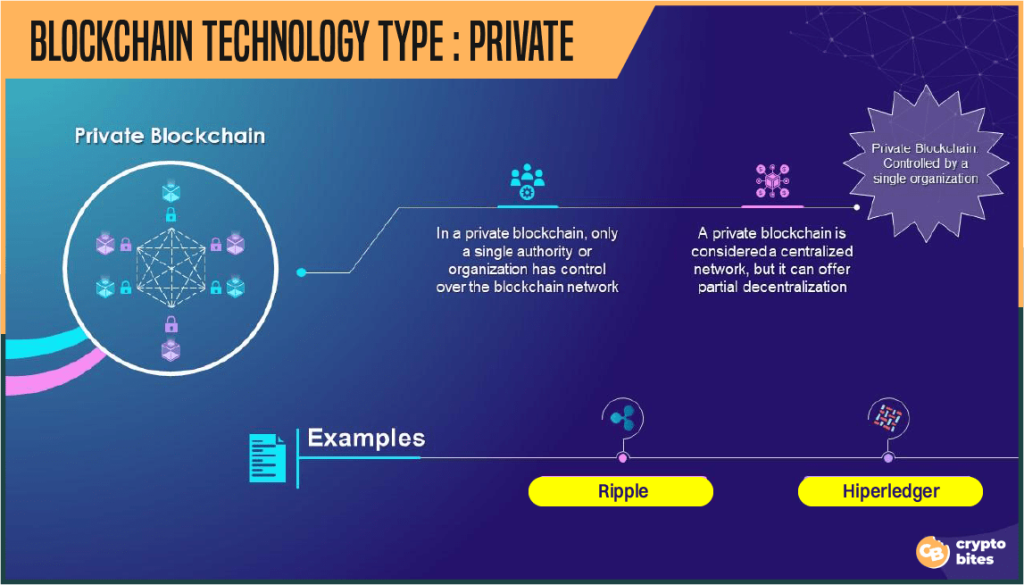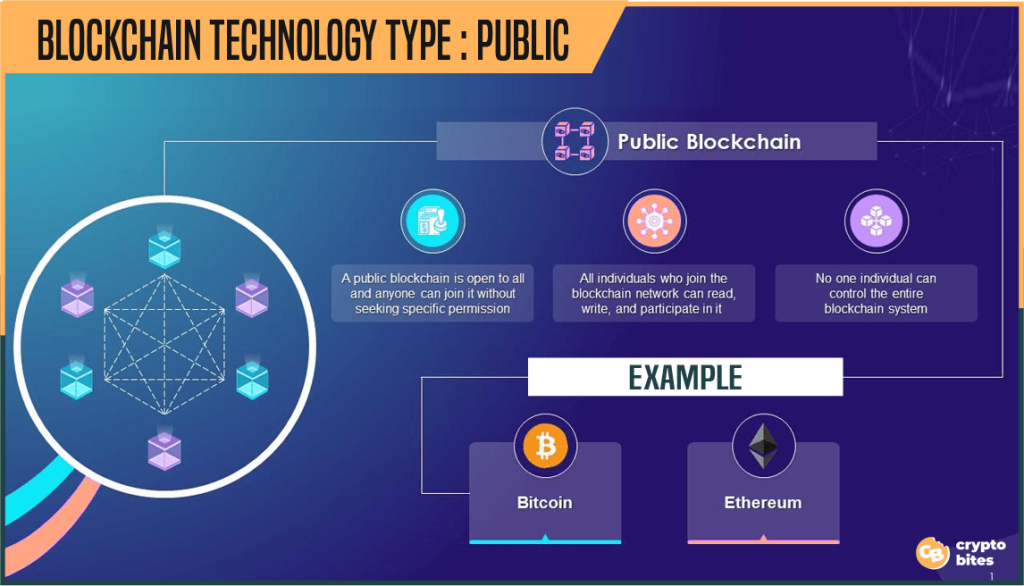
Public Blockchain vs Private Blockchain – How Do They Differ?
Public blockchains are way more popular than their private counterparts. Chances are that private blockchain will never be able to catch up.
By 2028, blockchain is set become a industry of a staggering $228 billon. It includes both public and private blockchains.
Despite the fuss, a lot of people don’t even know the differences between these two.
If you’re one of them, feel free to continue …
What is a Private Blockchain?
A private blockchain, also known as a permissioned blockchain, is a network where access is restricted to a single operator or entity. This entity controls who can join the network and what they can do once they’re in.
Unlike public blockchains that are open to anyone, private blockchains have rules related to who can see, transact, and create data. This setup gives more control and privacy over who’s involved and what they’re doing on the network.

Its often called the “trusted” blockchain which is all about keeping things private for businesses. Just like any other blockchain, it uses digital blocks to store info, starting with the first one called the Genesis block.
Each block after that links back to the one before it with a secret code, letting you track all the transactions right back to the start.
What is Public Blockchain?
A public blockchain functions without a central authority, allowing individuals to participate anonymously.
It’s decentralized, meaning it’s not controlled by any single organization or person. This type of blockchain is commonly associated with cryptocurrencies and NFTs.

Public blockchains are often referred to as “permissionless” and “trustless” because users can join and transact without needing permission from a central authority, and transactions can be verified without relying on trust in any specific entity.
There are several advantages to public blockchains. They are accessible to anyone with an internet connection, and all transactions are securely recorded and cannot be altered.
Additionally, the large number of nodes in the network provides robust security, making it highly resistant to attacks from cyber threats.
Public Blockchain vs Private Blockchain Table
This table demonstrates how these two types of blockchains differ:
| Aspect | Public Blockchain | Private Blockchain |
| Access Control | Open | Restricted access |
| Participants | Anonymous and open | Known and permissioned |
| Consensus Mechanism | Slower, energy-intensive | Faster, less energy-intensive |
| Decentralization | Fully decentralized | More centralized |
| Speed and Scalability | Slower and less scalable | Faster and scalable |
| Example | Bitcoin, Ethereum, Solana, Avalanche | Hyperledger Fabric, Corda |
| Security | Public blockchains tend to have higher security due to decentralization and distributed control among participants. | Private blockchains may have lower security as they rely on a smaller, known set of participants, creating a single point of failure. |
| Privacy | Public blockchains provide lower privacy as transactions are visible to all participants, ensuring transparency but reducing confidentiality. | Private blockchains offer higher privacy by restricting access to a select group, making them suitable for confidential business transactions. |
| Energy Usage | Public blockchains typically have higher energy usage due to the computational power required for decentralized consensus mechanisms like Proof of Work. | Private blockchains usually have lower energy usage as they operate with a smaller number of nodes and may use more energy-efficient consensus mechanisms. |
| Immutability | Public blockchains provide higher immutability as the decentralized nature ensures that once a transaction is recorded, it cannot be altered or deleted. | Private blockchains have lower immutability since permissions may allow certain participants to modify or delete transactions within the closed network. |
Difference in the Level of Anonymity
Another big difference between public and private blockchains is how anonymous you can be. Anonymity is super important for things like cryptocurrency, but businesses need to know who’s accessing their network, so they go for private blockchains.
In public blockchains, anonymity is key. With everyone staying anonymous, users can still access all the blockchain resources without revealing their identity. This anonymity builds trust among users and boosts confidence.
In a business environment, anonymity isn’t as useful because the company’s resources need to be kept under wraps and safe, that’s why knowing the users is extremely important for accountability.
Plus, it’s tricky to give specific permissions to users when you don’t know who they are. Since private blockchains are all about permissions, anonymity just doesn’t fit the bill. That’s why businesses often opt for private blockchains—they’re all about keeping things secure and controlled.
Difference in Transaction Speed
If you’ve ever bought or sold bitcoins on cryptocurrency exchanges, you might’ve noticed transactions taking a bit of time. Public blockchains usually move slower compared to private ones when it comes to transaction speed.
In a public blockchain, there could be loads of nodes in the network all accessing the ledger. Since each node has to keep its own copy of the ledger updated, transactions need to be logged and checked across the whole network. This process creates delays, and it’s something that every public blockchain has to deal with.
Private blockchains, on the other hand, don’t need as many nodes, which means they can record and verify transactions much faster than public blockchains. This speed is one of the major perks of private blockchains over public ones.
Decentralization vs. Centralization
When it comes to the debate between decentralization and centralization in blockchains, the difference might not be as stark as you think. In reality, all blockchains have some degree of decentralization. However, private blockchains tend to lean more towards centralization compared to public blockchains.
Absolute decentralization is a core characteristic of public blockchains, as it ensures the high level of security and accessibility they’re known for. With a public blockchain, the ledger can be stored and connected to the network on any compatible hard drive, allowing it to expand massively in a fully decentralized manner.
While private blockchains are partially decentralized, they must be centralized to some extent since they require control over the number of nodes in the network as well as user permissions. Since a private blockchain has fewer options for expanding into a vast decentralized network, it is frequently contained in a very protected ecosystem.
The Concept of Immutability and How it Applies
Immutability is a crucial aspect of any blockchain, ensuring that data can be added to the ledger without problems while also guaranteeing the permanence of recorded information over time. This distinction between public and private blockchains is significant, as opting for one over the other could have significant consequences.
Immutability is a rock-solid principle in public blockchains. Once data is on the ledger, it’s there to stay—no ifs, ands, or buts. The only way to make changes is to essentially abandon ship and create a new branch of the blockchain, starting from a point before the supposed “error,” or to scrap everything and begin anew from scratch.
In a private blockchain, the power to tweak the ledger whenever necessary is a perk that public blockchains don’t offer. Sometimes, a company might need to adjust a data point within the ledger, making a private blockchain the perfect fit. However, this ability to make changes can raise doubts about the network’s reliability among others.
Public vs Private Blockchain – Which Ones More Scalable?
Scalability is another factor contributing to the sluggishness of cryptocurrency transactions, as mentioned earlier. Some blockchains handle scalability better than others, depending on factors like the number of nodes, transaction volume, storage method, and consensus mechanism.
Public blockchains, especially those used for cryptocurrencies, are notorious for scalability issues. As the number of nodes and transactions grows, coupled with limits on block size and the intricacies of the consensus mechanism, the scalability of public blockchains is nearing its threshold.
On the other hand, you have significant control in private blockchain which allows for adjustments that can alleviate scalability challenges often encountered in public blockchains.
If a private blockchain experiences slower-than-expected performance, measures such as reducing the number of nodes, increasing the number of transactions stored per block, or modifying the consensus mechanism can lead to substantial enhancements in the blockchain’s scalability and overall performance.
The Final Judgement?
Public and private blockchains aren’t rivals because they cater to vastly different needs. While a company might opt for a private blockchain, there could still be advantages in making it public.
I’d say if you’re aiming for a blockchain that’s open, offers high anonymity, treats all users equally, and is fully transparent, a public blockchain is the way to go. Bitcoin, the most renowned cryptocurrency globally, serves as a prime example of a public blockchain.
But if your goal is to offer a blockchain with user identification, admin controls for permission management, top-notch performance, and restricted access, then a private blockchain is your best bet. Hyperledger stands out as a prime example of a private blockchain. Developed by The Linux Foundation, Hyperledger is a fully operational open-source blockchain technology.




